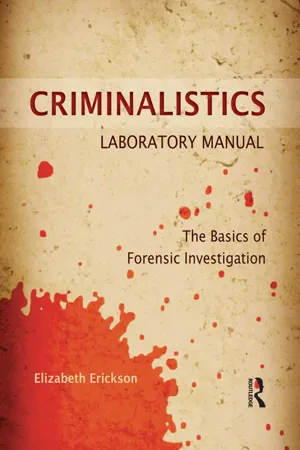
- 226 pages
- English
- ePUB (mobile friendly)
- Available on iOS & Android
eBook - ePub
About this book
The Criminalistics Laboratory Manual: The Basics of Forensic Investigation provides students with little to no prior knowledge of forensic science with a practical crime scene processing experience. The manual starts with an original crime scene narrative setting up the crime students are to solve. This narrative is picked up in each of the forensic science lab activities, tying each forensic discipline together to show the integrated workings of a real crime lab. After the completion of all of the exercises, the student will be able to solve the homicide based on forensic evidence.
Frequently asked questions
Yes, you can cancel anytime from the Subscription tab in your account settings on the Perlego website. Your subscription will stay active until the end of your current billing period. Learn how to cancel your subscription.
No, books cannot be downloaded as external files, such as PDFs, for use outside of Perlego. However, you can download books within the Perlego app for offline reading on mobile or tablet. Learn more here.
Perlego offers two plans: Essential and Complete
- Essential is ideal for learners and professionals who enjoy exploring a wide range of subjects. Access the Essential Library with 800,000+ trusted titles and best-sellers across business, personal growth, and the humanities. Includes unlimited reading time and Standard Read Aloud voice.
- Complete: Perfect for advanced learners and researchers needing full, unrestricted access. Unlock 1.4M+ books across hundreds of subjects, including academic and specialized titles. The Complete Plan also includes advanced features like Premium Read Aloud and Research Assistant.
We are an online textbook subscription service, where you can get access to an entire online library for less than the price of a single book per month. With over 1 million books across 1000+ topics, we’ve got you covered! Learn more here.
Look out for the read-aloud symbol on your next book to see if you can listen to it. The read-aloud tool reads text aloud for you, highlighting the text as it is being read. You can pause it, speed it up and slow it down. Learn more here.
Yes! You can use the Perlego app on both iOS or Android devices to read anytime, anywhere — even offline. Perfect for commutes or when you’re on the go.
Please note we cannot support devices running on iOS 13 and Android 7 or earlier. Learn more about using the app.
Please note we cannot support devices running on iOS 13 and Android 7 or earlier. Learn more about using the app.
Yes, you can access Criminalistics Laboratory Manual by Elizabeth Erickson in PDF and/or ePUB format, as well as other popular books in Law & Criminal Law. We have over one million books available in our catalogue for you to explore.
Information
1
Laboratory #1 The Crime Scene Sketch
Chapter Outline
- 1.1 Crime Scene Sketches
- 1.2 Laboratory Exercise: Crime Scene Sketch
Learning Objectives
- Explain the various types of sketches
- Complete a rough sketch
- Complete a final sketch
- Demonstrate measurements within a crime scene
- Measure evidence using triangulation
What you will Learn
Laboratory #1, The Crime Scene Sketch, introduces the student to the various search techniques used for processing different types of scenes, such as indoor venues versus outdoor venues. The search techniques are explained with examples and suggestions for when to use one search technique over another. The use of triangulation is explained to measure evidence within a scene, which is also used for the laboratory exercise. Required information for a crime scene sketch is included with information on standard and military time conversions. The chapter ends with a laboratory exercise to show proficiency with creating a rough and final indoor crime scene sketch.
Key Terms
- demonstrative evidence
- elevation sketch
- enlarged sketch
- exploded sketch
- final sketch
- location sketch
- overview sketch
- rough sketch
Case File: 00-123456
After Officers Brown and O’Donnell realized that a double homicide had occurred, detectives, crime scene technicians, and the medical examiner were contacted for further processing of the scene. When the detectives arrived, the entire scene was cordoned off to prevent unnecessary people from entering and exiting in the hopes of preventing contamination. The detectives began to work on assessing the circumstances of the case and recreating the events that led to two deaths by interviewing witnesses, including Lynette Saunders.
While the detectives interviewed witnesses, the crime scene technicians and the medical examiner arrived to collect evidence from the scene. The crime scene technicians began to search the scene to locate possible evidence related to the homicide. The technicians located multiple pieces of evidence and placed yellow photo markers next to each item for future photographs, measurements, and finally collection.
The medical examiner checked each body and made observations about the location of each body and noted any outward signs that could assist with time of death determinations, such as rigor, livor, and algor mortis. Once the evidence was photographed around the body, the medical examiner took possession of the body for transport to the morgue.
Evidence Found at the Scene
The crime scene technicians found the following evidence at the crime scene:
- Multiple fingerprints located around the house and in the master bedroom
- Footwear impressions in blood located in the master bedroom and upstairs hallway
- Footwear impressions located outside the rear entrance to the Ashley residence
- Tool mark impressions on the outside of the rear entrance to the Ashley residence
- Red stains presumed to be blood located on the outside front stoop of the Ashley residence
- One blank pad of paper recovered from the kitchen counter
- Cigarette butts found outside at the rear of the Ashley residence
- One crowbar recovered from the master bedroom
- Two cartridge casings recovered from the master bedroom floor near William Ashley
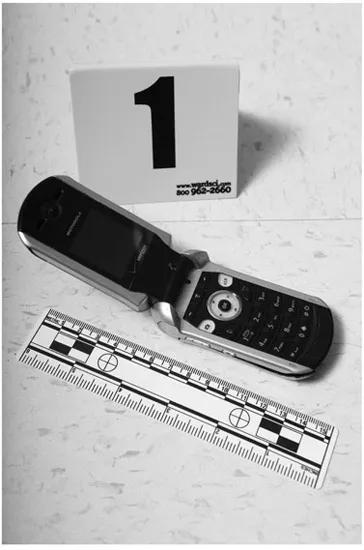
Cell phone found at the scene.
- Three cartridge casings recovered from the master bedroom floor near the foot of the bed
- Multiple hairs and fibers recovered from locations throughout the master bedroom
- Small piece of glass recovered from the master bedroom carpet
- Glass fragments located in the back hallway of the Ashley residence
- Small plastic bag containing a white powdery substance found on the front hallway floor
- Three empty pill bottles found on the upstairs hallway floor
- One pill bottle containing eight small blue tablets located outside in the bushes of the Ashley residence
- One diamond ring located outside on the ground
- One American Express card located outside on the ground
- One pair of black sunglasses located on the kitchen floor of the Ashley residence
- One cell phone located in the front hallway

Cartridge casings.
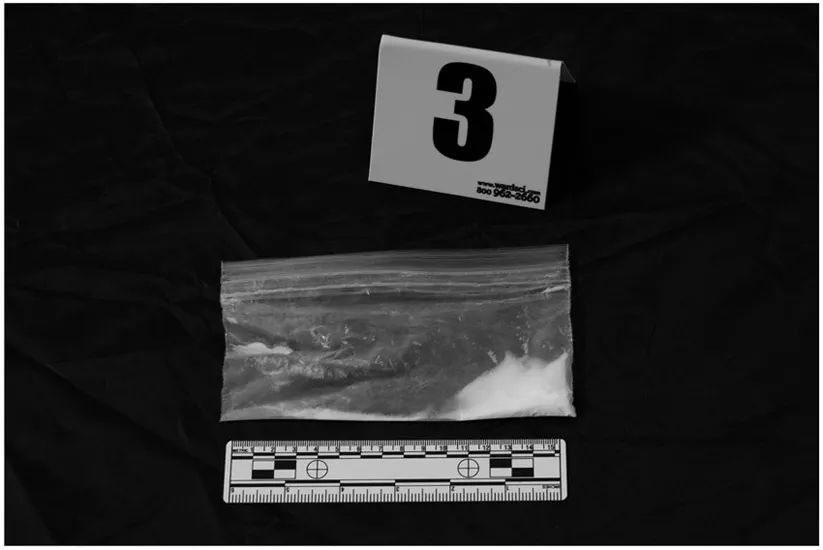
Small plastic bag containing white powder.
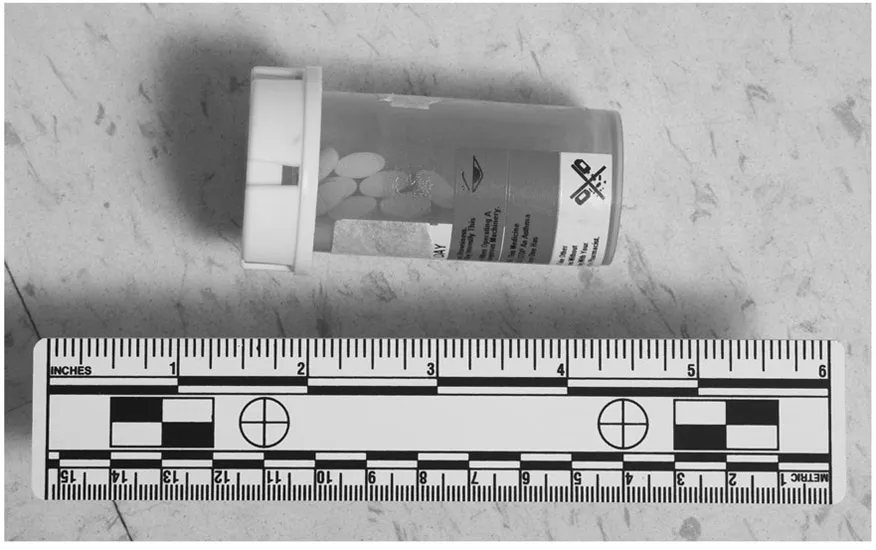
Pill bottle.
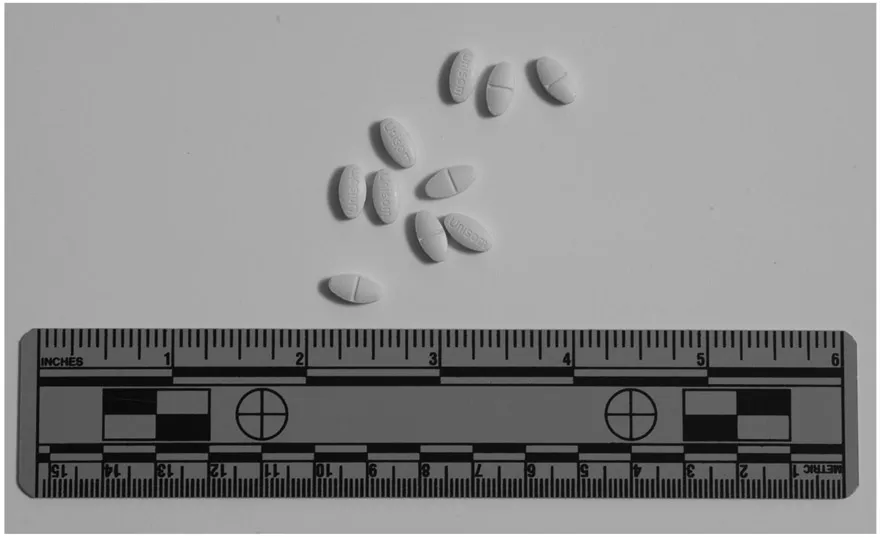
Pills.
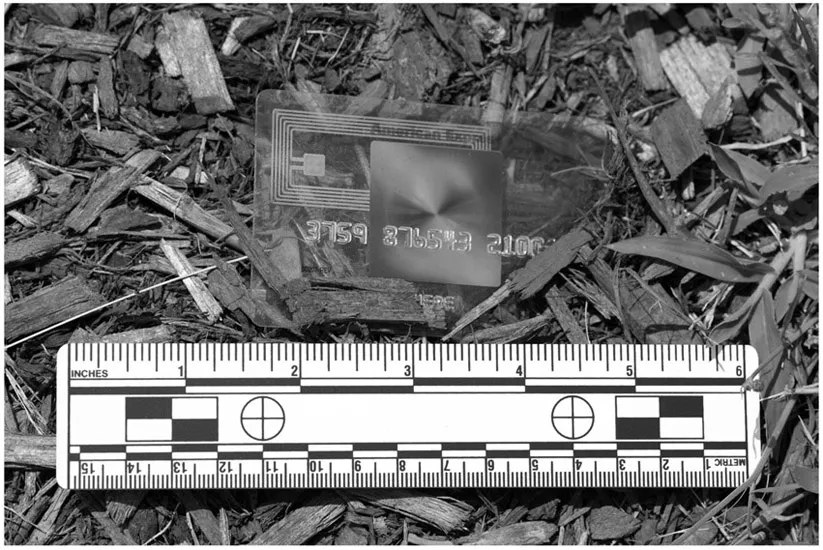
American Express card.
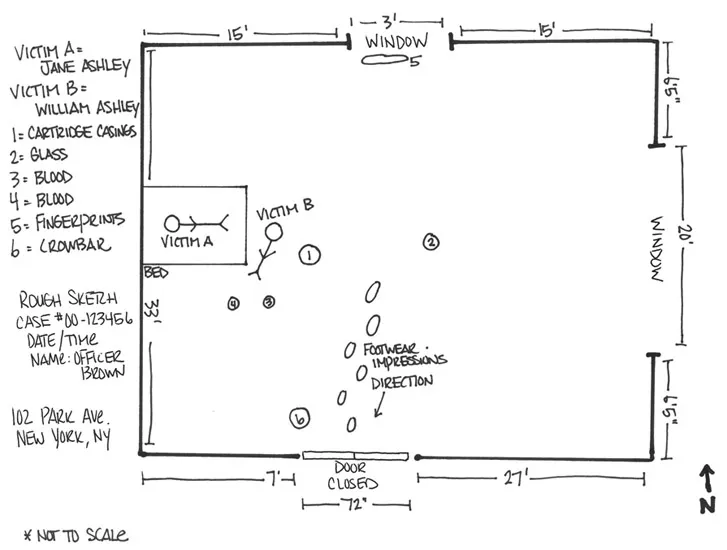
Sketch of where the bodies were located.
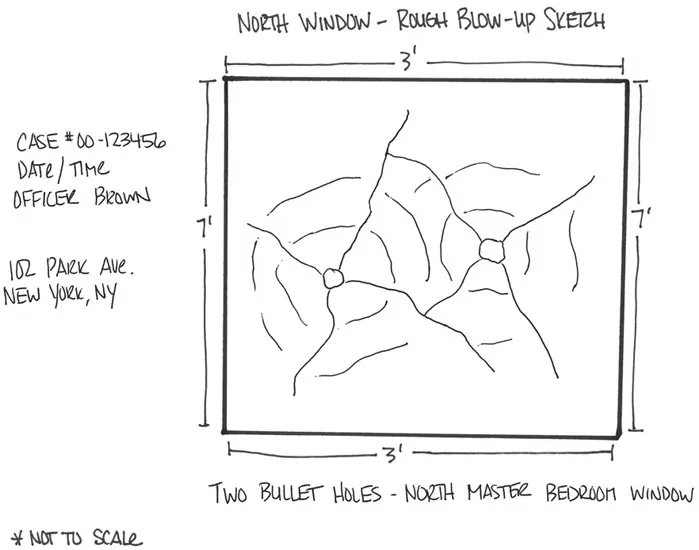
North window: Blown-up sketch.
1.1
Crime Scene Sketches
At major crime scenes, including homicides, a crime scene sketch must be made to accompany the pictures and the incident report describing the scene. The sketch is typically drawn by one of the technicians, but with recent technological advances, some departments have the capability of using crime scene sketching software to create a more realistic diagram for court presentation. Depending on the type of scene, multiple sketches would be completed to depict the entire area, specific locations with the body and/or evidence, location of events, etc.
Investigative Tip
A word processing program can be used to draw the basic perimeter of the c...
Table of contents
- Cover
- Half Title
- Title
- Copyright
- DEDICATION
- CONTENTS
- Preface
- Digital Assets
- Introduction: The Crime
- Chapter 1 LABORATORY #1 The Crime Scene Sketch
- Chapter 2 LABORATORY #2 Photography
- Chapter 3 LABORATORY #3 Evidence Collection
- Chapter 4 LABORATORY #4 Autopsy/Wound Documentation
- Chapter 5 LABORATORY #5 Fingerprint Processing
- Chapter 6 LABORATORY #6 Fingerprint 10-Print Card
- Chapter 7 LABORATORY #7 Questioned Document Examination
- Chapter 8 LABORATORY #8 Footwear and Tire Impressions
- Chapter 9 LABORATORY #9 Tool Marks
- Chapter 10 LABORATORY #10 Odontology
- Chapter 11 LABORATORY #11 Blood Typing and Biological Fluids
- Chapter 12 LABORATORY #12 Blood Spatter Analysis
- Chapter 13 LABORATORY #13 Glass
- Chapter 14 LABORATORY #14 Hair and Fiber
- Chapter 15 LABORATORY #15 Drugs and Toxicology
- Chapter 16 LABORATORY #16 Digital Forensics
- Chapter 17 LABORATORY #17 The Trial
- References
- Appendix: Blank Forms for Exercises